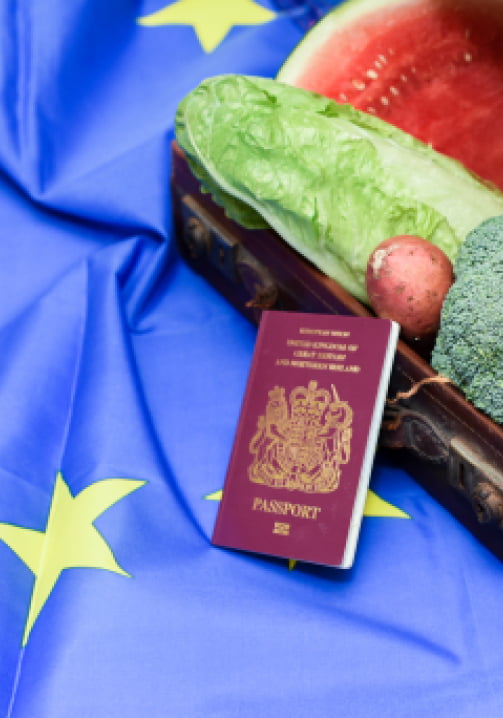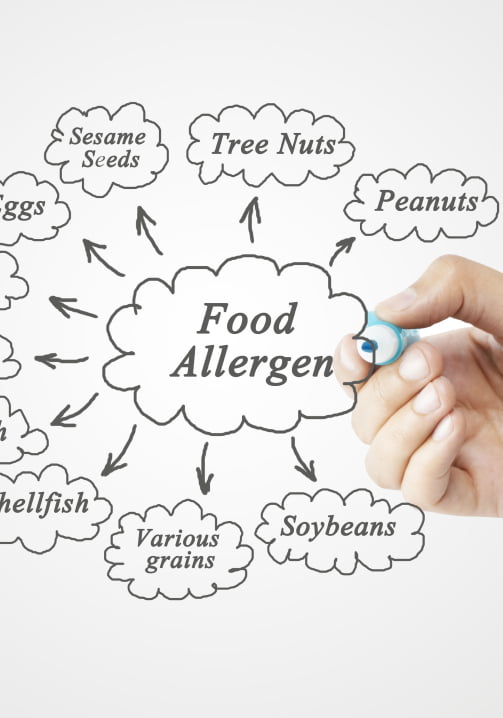
Allergies are adverse reactions from the body to a normally harmless substance which affects one in four people in the UK (M.L.Levy, 2004).The reaction comes specifically from the immune system, usually responsible for fighting viruses and germs. The reasons for the rise in isn’t well understood, however, we believe that it could be down to our cleaner environments, which is reducing what our immune systems are exposed to, causing them to overreact to harmless substances.
The usual way the immune system works is to attack harmful viruses or bacteria, such as Salmonella or Staphylococcus aureus, when they enter the body. Trillions of white blood cells make up an important part of our immune system and travel around the body to detect anything harmful. When they detect what is believed to be a harmful substance, the white blood cells will direct the production of immunoglobulin, which is a protein also known as an antibody. Immunoglobulin will then bind to the harmful substance, such as viruses or bacteria, to make it harmless. Antibodies are extremely unique. Each harmful substance requires a different antibody to fight it. Trying to fight a flu virus with an antibody for Salmonella simply won’t work. So, each time a new substance enters the body, new specific antibodies are produced by the body to fight it.
In people who have allergies, the body works exactly as it should for fighting viruses and bacteria. However, it also responds to harmless substances as though they were attackers. When this happens, the immune system becomes sensitive to the substance and produces antibodies against it, which programs the immune system to react to whenever the substance enters the body.
Read More
- Milk
- Lupin
- Shellfish
- Molluscs
- Gluten
- Wheat
- Eggs
- Fish
- Celery
- Nuts
- Peanuts
- Sesame
- Soy
- Sulphur Dioxide

- Swelling of lips, tongue, and face
- Itchy rash on the skin, usually arms, legs, and throat
- Shortness of breath/coughing,
- Runny nose, and inflamed eyes
- Swelling of the voice box
- Abdominal pain
- Nausea and vomiting
- Collapsing with shock (Anaphylaxis)
These symptoms are caused by the immune system responses. They can occur within minutes of the allergen being ingested. Occasionally, other symptoms can come later, like abdominal pain and increased rashes.
Read More
Allergies – a reaction produced by the body’s immune system when exposed to a normally harmless substance.
Sensitivity – an increased reaction to a particular substance such as when caffeine causes palpitations and trembling.
Intolerance – when a substance causes unwanted symptoms, such as diarrhoea. This reaction doesn’t involve the immune system, and people who are affected are usually okay with small amounts. However, the symptoms worsen as the amount ingested increases.

Crustaceans
A crustacean is an animal with a hard outer-shell and several pairs of legs, which usually live in water. The most common of these are crabs, lobsters, and shrimps. Being allergic to one type of crustacean doesn’t necessarily mean having an allergy to all. However, around 75% of people who are allergic to one type will have a reaction to other crustaceans.
Allergies to shellfish, crustaceans and molluscs are not necessarily related to fish allergies.
The allergen associated with crustaceans and shellfish is called tropomyosin.
Molluscs.
This group of shellfish includes species such as clams, mussels, octopus, and scallops, though they are not exclusively seafood. Molluscs also include species of snails and other land animals.
An exception is the Kosher product carrageenan which is used for setting creams by reaction with calcium. This is produced from red marine algae however does not come under shellfish for allergen stating purposes.
Read More
Dermatitis Herpetiformis
Affecting 1 in 3,300 people this is known more commonly as gluten rash. It is a red and extremely itchy skin rash. This is why people can easily adopt the term gluten allergy. Medically, an allergy to gluten is unrecognized and the term has been adopted by the use of online medical forums and word of mouth.
The rash is caused by clogs in small blood vessels of the skin where antibodies latch on to gluten proteins believing them to be a threat to the body and release a chemical called complement which causes the rash. This can also damage the parts of the intestines that allow the absorption of vitamins and minerals.
Read More
Peanut Oil
Using peanut oil is a controversial topic for chefs and customers with food allergies, normally avoided completely to prevent any devastating mistakes. Highly-refined peanut oil poses little to no risk to people with a peanut allergy. In an unlikely event of reaction, it would be very mild. Without full understanding, though, this can lead people to believe that all peanut oil is fine for those with peanut allergies. On the other hand, unrefined peanut oil contains traces of peanut proteins and can cause serious reactions and anaphylaxis. Confusing these two is an easy mistake to make and the use of the wrong type could, in the worst-case scenario, be fatal. Avoiding it completely would be a good recommended course of action if a customer has a peanut allergy.
Read More
1. Check your supplier’s processes
If you use external suppliers, then it is always important to understand what is going on in their kitchens or facilities. Make sure you ask which allergens your supplier uses and if they can guarantee the produces are free from contamination. Make sure that fresh products arrive with no signs of cross-contamination with other products, e.g. split bags or mixed products such as carrots and celery packaged together.
2. Label Products with Allergens
Another major step to preventing contamination or mistake is by labelling products with the allergies that they contain. This can either be written on a label or by using color-coded/tick box stickers.
3. Separate items into storage
Try to have dedicated spots in the storage areas and fridges for certain products that contain one of the 14 allergens.
Read More
Vegetarian
Vegetarians follow a diet that does not include the consumption of any part of an animal. This includes fish, meat, poultry, shellfish, or insects. Apart from meat, they are also wary of products containing gelatine, animal rennet, stocks or fats as they can be produced from animals. Vegetarians can eat eggs and dairy products.
Read More
Type 2 diabetes has different causes, however, the effects and treatment remain the same. Keeping sugar content of food as low as possible is recommended when cooking for diabetics. While their sugar levels can be managed by the individual, it’s important to check with them directly, disclosing the ingredients used and advising on the choices, especially with desserts.

The blood must be drained from the animal completely. This does not apply to seafood, but there are specific rules and exceptions for uncommonly used animals like reptiles, birds with talons, and pests. If in doubt, it is best to check on a case-by-case basis. The main ingredients to be on the lookout for are pork, product of pork, e.g. gelatine, alcohol, anything that contains the blood of an animal or animals, animal products derived from meat that hasn’t been killed in the correct way.

Legislation
Since 13th of December 2014, the EU Food Information for Consumers Regulation has been in force. These are EU rules which are also enforced in the UK by the Food Information Regulations. This legislation requires food businesses to provide information on the 14 key allergens to their customers. Also, if a customer asks about an allergen not on the list, we must able to give the correct information regarding that particular ingredient.
Allergen information must be available either on the menu or in other written form for reference. How you present it is up to you. However, it must be easily accessible and clear. It is no longer enough to state, “All foods may contain allergens.” Information provided must be specific to particular allergens. If serving a buffet, each item must have its own allergen list. Not providing information or providing incomplete information about the products you sell can lead to penalties from the health authorities, and also legal claims from customers.
Allergens on the rise
These are not part of the compulsory list, however, it is worth noting the rise in the population reporting an allergy to the following products: kiwi fruit, bananas, peas, lentils, chickpeas, tomatoes, mushrooms.

One, effective cleaning/handwashing and equipment washing, using hot water and the correct cleaning chemicals followed by sanitization.
Two, separation of products. Covering foods with lids or clean film using clean knives and equipment for each job. Separate areas should be also used whenever possible.
Three, separation of cooking equipment. Make sure that different deep fat friers for different allergen-containing products. And also that pans and hot plates are cleaned thoroughly between uses.
Four, check packaging. Always check the packaging for breakages and potential cross-contamination with other products. Also, know any spillages of allergen products that may have contaminated and separate products.
Read More
- Recognize the potentially life-threatening risks that are associated with food allergies.
- Comply with the requirements of the Food Information Regulations 2014 and other food law which may protect people with allergies and intolerances.
- Document the allergens present in the foods that we serve by liaising with our suppliers and collating the information through ingredient specifications and labels.
- Identify the specific allergens where we have groups of foods such as cereals, crustaceans, fish, nuts, and molluscs. Ask suppliers to ensure we are advised should there be any changes to the relevant allergen information.

- Keep the person lying down with legs raised (especially if they are faint or dizzy).
- (If they are conscious and having asthma or breathing difficulties, it may be better for them to sit up and lean over a table).
- Call 999 immediately and state anaphylaxis.
- Check if the customer has an adrenaline auto-injector and can self-administer into their thigh. Unless you have received specific training in its correct use, do not administer the auto-injector. The customer may have a family member or friend who can help.
- Send someone outside to wait for the ambulance and stay with the person until qualified help arrives.


2. Manager talks with and clarifies customer needs. This is then relayed to the front of house and kitchen staff.
3. Kitchen must handle the order as mindfully as possible using different equipment and separation to reduce the risk of cross-contamination.
4. Waiting staff must communicate to ensure that the correct food reaches the correct customer, referring to the manager if needed.
HAVE A QUESTION?
Talk to the Chef



